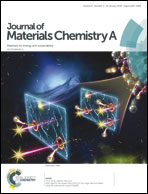Functional adlayers on Au electrodes: some recent applications in hydrogen evolution and oxygen reduction
Abstract
The Mo–S based inorganic salt ATM (ammonium tetrathiomolybdate) and cysteine containing peptides can form self-assembled adlayers on Au surfaces and these modified electrode materials exhibit miscellaneous catalytic activities. The ATM modified Au electrode catalyses the evolution of H2 from water even in the presence of O2 and other inhibitors. Moreover, water insoluble iron–porphyrins get immobilised on this construct through physiadsorption and thus it becomes a favourable ORR (O2 reduction reaction) catalyst. A naturally occurring peptide Ay(1–19), containing native cysteine residues, spontaneously forms an ordered SAM (self-assembled monolayer) on Au and upon heme binding this construct can catalyse the ORR with a higher catalytic rate compared to synthetic metallo-porphyrin based ORR catalysts. Human Aβ(1–16), appended with a cysteine residue at its C-terminus, gets readily immobilised on Au surfaces by SAM formation. These AβCys constructs represent different isoforms of Aβ in the absence and in the presence of various coadsorbant thiols. Upon individual as well as simultaneous binding of heme and Cu, these structurally different AβCys constructs exhibit diverse trends in generating oxidative stress, in vitro.

- This article is part of the themed collection: Recent Review Articles


 Please wait while we load your content...
Please wait while we load your content...